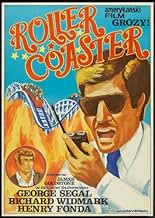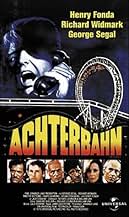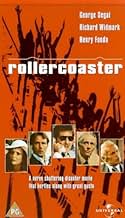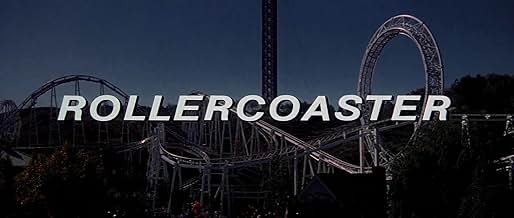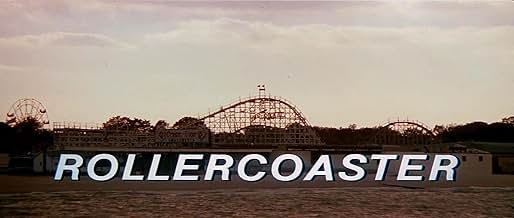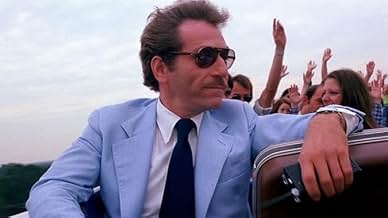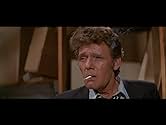NOTE IMDb
6,3/10
7,3 k
MA NOTE
Un maître chanteur menace de saboter les montagnes russes de divers parcs d'attractions américains s'il ne reçoit pas une rançon considérable.Un maître chanteur menace de saboter les montagnes russes de divers parcs d'attractions américains s'il ne reçoit pas une rançon considérable.Un maître chanteur menace de saboter les montagnes russes de divers parcs d'attractions américains s'il ne reçoit pas une rançon considérable.
- Réalisation
- Scénario
- Casting principal
Avis à la une
Rollercoaster was released at a time when disaster movies were very popular. I guess that's why it's been labeled by many critics as exactly that. But it's not. It's a very clever thriller with some great dialogue. I wasn't too surprised that Columbo creators Richard Levinson and William Link co-developed the story and wrote the screenplay. Especially the conversations between George Segal and Timothy Bottoms are just as good as anything you've ever seen on Columbo. This is a very underrated movie and during all the Sensurround hype the finer qualities of it got overlooked. So maybe next time you get a chance watch it again. Perhaps you'll be surprised.
Rollercoaster is directed by James Goldstone and co-adapted to screenplay by Sanford Sheldon, Richard Levinson and William Link from a suggested Tommy Cook story. It stars George Segal, Timothy Bottoms, Richard Widmark, Harry Guardino, Susan Strasberg and Helen Hunt. A Panavision/Technicolor production in Sensurround, it features music by Lalo Schifrin and photography by David M. Walsh.
A psychopathic bomber known only as "Young Man" (Bottoms) is causing terror at American theme parks. When safety inspector Harry Calder (Segal) is brought in to investigate, it sets off a cat and mouse game as the "Young Man" ups the ante...
Even now Rollercoaster is still wrongly being lumped in with the disaster movie genre that surfaced in the 1970s. Released at a time when that particular genre of film was fading out, Rollercoaster is anything but a disaster movie. What it is, in fact, is a psychopath character based thriller that adheres to procedural values and character involvement. As it runs at nearly two hours in length should notify viewers that it isn't a film chocked full of Rollercoaster sequences and explosive pyrotechnics. Yes, there's some exciting "Coaster" sequences, neatly shown to us in POV, and in spite of the (obvious 1970s) use of dummies for the plot set up carnage, this thrives on human interest and race against the clock suspense.
The marker is set early on as Bottoms' smirking killer sets up his first murderous act whilst listening to some deathly string arrangement on his cassette player. We then segue into funfair music as the joys of the amusement park brings a warmth and calm to the viewer, this however is soon vanquished as the terror that a terrorist can bring comes right to the fore. From here on in the Bottoms character remains mysterious, but we now know just what he is capable of. Likewise does Segal's character, as do the likes of Widmark's Agent Hoyt and the rest of the "suits" frantically scratching around trying to avert further tragedy as the fresh faced bomber demands money with menaces. This ensures the bulk of the film is made up of Calder and Young Man interactions and police procedural movements. It has much talk, very much so, but it's well scripted dialogue and heightens the tension as we enter the final third.
One of the few films to feature the Sensurround gimmick, the film perhaps logically loses much impact on the small screen. Prints of the film are only adequate, and the sound mix doesn't shake your lounges in the way it certainly did back in 1970s theatres. Yet this is still a damn fine suspense picture, a pic that also carries with it some stoic performances from Segal and Widmark - and a chillingly effective villainous turn from the undervalued Bottoms. Henry Fonda is on the credits, but really it's just an early cameo appearance, while there's much interest value in watching future Academy Award winner Helen Hunt as the young daughter of Harry Calder.
Expect a taut thriller like "Two-Minute Warning", which was released the previous year, and you hopefully will not feel at all let down. Expecting a two hour disaster movie full of Coaster Carnage, however, will only lead to a crushing disappointment. 8/10
A psychopathic bomber known only as "Young Man" (Bottoms) is causing terror at American theme parks. When safety inspector Harry Calder (Segal) is brought in to investigate, it sets off a cat and mouse game as the "Young Man" ups the ante...
Even now Rollercoaster is still wrongly being lumped in with the disaster movie genre that surfaced in the 1970s. Released at a time when that particular genre of film was fading out, Rollercoaster is anything but a disaster movie. What it is, in fact, is a psychopath character based thriller that adheres to procedural values and character involvement. As it runs at nearly two hours in length should notify viewers that it isn't a film chocked full of Rollercoaster sequences and explosive pyrotechnics. Yes, there's some exciting "Coaster" sequences, neatly shown to us in POV, and in spite of the (obvious 1970s) use of dummies for the plot set up carnage, this thrives on human interest and race against the clock suspense.
The marker is set early on as Bottoms' smirking killer sets up his first murderous act whilst listening to some deathly string arrangement on his cassette player. We then segue into funfair music as the joys of the amusement park brings a warmth and calm to the viewer, this however is soon vanquished as the terror that a terrorist can bring comes right to the fore. From here on in the Bottoms character remains mysterious, but we now know just what he is capable of. Likewise does Segal's character, as do the likes of Widmark's Agent Hoyt and the rest of the "suits" frantically scratching around trying to avert further tragedy as the fresh faced bomber demands money with menaces. This ensures the bulk of the film is made up of Calder and Young Man interactions and police procedural movements. It has much talk, very much so, but it's well scripted dialogue and heightens the tension as we enter the final third.
One of the few films to feature the Sensurround gimmick, the film perhaps logically loses much impact on the small screen. Prints of the film are only adequate, and the sound mix doesn't shake your lounges in the way it certainly did back in 1970s theatres. Yet this is still a damn fine suspense picture, a pic that also carries with it some stoic performances from Segal and Widmark - and a chillingly effective villainous turn from the undervalued Bottoms. Henry Fonda is on the credits, but really it's just an early cameo appearance, while there's much interest value in watching future Academy Award winner Helen Hunt as the young daughter of Harry Calder.
Expect a taut thriller like "Two-Minute Warning", which was released the previous year, and you hopefully will not feel at all let down. Expecting a two hour disaster movie full of Coaster Carnage, however, will only lead to a crushing disappointment. 8/10
I'd watched this thriller/disaster movie on Italian TV as a kid; I was looking forward to re-acquainting myself with it via the Universal DVD, as part of my ongoing Richard Widmark tribute but, unfortunately, the viewing was plagued by multiple freezing and jumps (beginning at the 47-minute mark and recurring every quarter of an hour or so thereafter!).
Despite some pacing problems which render the film a tad overlong, Roller-coaster is entertaining and fairly solid as these things go: once again, the casting sees a star in every major role. George Segal is the safety officer hero (his intelligence concealed by an essentially bemused countenance, he's ideal for playing the slightly neurotic common man suddenly thrust in the midst of a precarious situation), Timothy Bottoms the young extortionist/bomber (whose targets are various amusement parks across the U.S.), and Widmark plays the veteran F.B.I. agent out to get him (he also shares a typically antagonistic relationship with Segal). Henry Fonda appears as the hero's cantankerous boss (though featured in many of these films, his roles were always brief and basically thankless), Susan Strasberg as Segal's current girlfriend, Harry Guardino a local cop (curiously enough, he had appeared with both Widmark and Fonda in MADIGAN [1968], another policier but much classier). By the way, Segal's daughter here is played by a very young Helen Hunt!
Another interesting connection to an earlier thriller featuring a member of the film's cast is NO WAY TO TREAT A LADY (1968) with Segal; in both titles, the hero is contacted by the killer prior to making his moves (with this in mind, Bottoms' clean-cut appearance lends the latter a chilling quality though the characterization, in itself, is fairly limited). Incidentally, the film is more concerned with the chase for the killer (generating reasonable suspense towards the end especially in the way he determines to plant another bomb on an inaugural roller-coaster ride after his initial gizmo is detected) rather than depicting his mayhem; in fact, there's only one major disaster sequence early on (but it's an undeniably spectacular one)! I should mention, at this point, Lalo Schifrin's rather schizophrenic music the carousel jingle is quite effective, but the scoring of the suspense sequences is gratingly monotonous!
P.S. Director Goldstone followed this with another star-studded epic WHEN TIME RAN OUT (1980), about an erupting volcano which, however, was a notorious production that brought the disaster movie cycle to a lamentable conclusion. I wouldn't mind revisiting it at this stage, though
Despite some pacing problems which render the film a tad overlong, Roller-coaster is entertaining and fairly solid as these things go: once again, the casting sees a star in every major role. George Segal is the safety officer hero (his intelligence concealed by an essentially bemused countenance, he's ideal for playing the slightly neurotic common man suddenly thrust in the midst of a precarious situation), Timothy Bottoms the young extortionist/bomber (whose targets are various amusement parks across the U.S.), and Widmark plays the veteran F.B.I. agent out to get him (he also shares a typically antagonistic relationship with Segal). Henry Fonda appears as the hero's cantankerous boss (though featured in many of these films, his roles were always brief and basically thankless), Susan Strasberg as Segal's current girlfriend, Harry Guardino a local cop (curiously enough, he had appeared with both Widmark and Fonda in MADIGAN [1968], another policier but much classier). By the way, Segal's daughter here is played by a very young Helen Hunt!
Another interesting connection to an earlier thriller featuring a member of the film's cast is NO WAY TO TREAT A LADY (1968) with Segal; in both titles, the hero is contacted by the killer prior to making his moves (with this in mind, Bottoms' clean-cut appearance lends the latter a chilling quality though the characterization, in itself, is fairly limited). Incidentally, the film is more concerned with the chase for the killer (generating reasonable suspense towards the end especially in the way he determines to plant another bomb on an inaugural roller-coaster ride after his initial gizmo is detected) rather than depicting his mayhem; in fact, there's only one major disaster sequence early on (but it's an undeniably spectacular one)! I should mention, at this point, Lalo Schifrin's rather schizophrenic music the carousel jingle is quite effective, but the scoring of the suspense sequences is gratingly monotonous!
P.S. Director Goldstone followed this with another star-studded epic WHEN TIME RAN OUT (1980), about an erupting volcano which, however, was a notorious production that brought the disaster movie cycle to a lamentable conclusion. I wouldn't mind revisiting it at this stage, though
10tsar65
This is probably my favorite childhood film having seen it 30 times at the theater during the summer of '77 (to put it in perspective I only saw Star Wars 12 times) and it still holds up very well. I'm sure part of that is the nostalgia factor as it seems to capture a time and place(s) pretty well, but there's a bit more to its appeal to me than that. It works because none of the characters are grossly exaggerated caricatures but everyday men with foibles like struggling to quit smoking. The Caulder character is identifiable because of his family and work failings while Bottom's soft-spoken psychopath (which probably would be portrayed as over the top if the movie were to be made now) is much more in tune with an understated realism that most contemporary madmen you see on screen today lack. While the Widmark character of Hoyt is a pretty much by the book portrayal of a federal dick, his sardonic exchanges with Segal lend an heir of authentic, yet begrudging mutual respect. That credit should go to the screenwriters. Henry Fonda's exchanges with Caulder are similar in their edge and that makes for an understanding of what Harry is up against in trying to stop the bomber. Susan Strasberg as Caulder's love interest is sympathetic, and very pretty, but isn't given much screen time outside of being a nanny for Caulder's daughter...a minor complaint to be sure.
After Roller-coaster came down from my long since demolished local three screen multiplex and had its initial HBO run it sadly all but seemed to disappear from my life, outside of an occasional run on late night TV during the eighties, but reappeared in 1998 when I stumbled upon a VHS copy from a company called GOODTIMES at a Tower Record store in Seattle. I was ecstatic. I still pull it off the shelf every once in awhile to remind myself that some of the minor films of the seventies that weren't appreciated in their day deserve another view.
After Roller-coaster came down from my long since demolished local three screen multiplex and had its initial HBO run it sadly all but seemed to disappear from my life, outside of an occasional run on late night TV during the eighties, but reappeared in 1998 when I stumbled upon a VHS copy from a company called GOODTIMES at a Tower Record store in Seattle. I was ecstatic. I still pull it off the shelf every once in awhile to remind myself that some of the minor films of the seventies that weren't appreciated in their day deserve another view.
A mysterious young man (Bottoms) derails a Roller-coaster with a bomb, killing or injuring passengers, then attacks more amusement parks across the US in order to extort $1m from the companies running them. It is not immediately obvious that these attacks were deliberate, as opposed to being accidents (e.g. through metal fatigue), so the Amusement Park owners can keep what is happening quiet. It also makes it easier for the extortionist as he has public hysteria to threaten the owners with if they don't pay him off.
Harry Calder (Segal) works for Standards and Safety. He had inspected the derailed Roller-coaster, realises other amusement parks have suffered similar problems and finds out about the plot. Calder gets involved more deeply than he envisaged, as he becomes a reluctant 'bag man' for the $1m, whilst the FBI try to catch the mystery man, just as the US heads towards 4th July and a wealth of potential targets.
This movie is a decent suspense thriller and I have seen it several times. I have never regarded it as part of the 'disaster' movie genre and feel such a description is both lazy and inappropriate. Whilst the Roller-coaster crash scenes were fairly horrible for the time, they seem pale today. The horror is in the mind, and there are only a couple of such scenes in the movie. It is not therefore a bloody horror flick, either.
I don't know if this misconception comes from bad marketing, suggesting that this is a disaster movie, or if there were suggested scenes of gore and blood for the horror fans, in order to con people into the cinema, or if this is down to the critics of the time being lazy and perhaps even reviewing a movie they didn't see. I am a little too young to have seen or read anything at the time.
This is a suspense thriller, even though there is no suspense about 'whodunit', but the movie's style is familiar and it is no surprise to see 'Columbo' creators Levinson and Link in the credits.
The strength of this movie is the cynical, maverick, but quick-witted Calder character that is played so well by Segal. He also has the often-amusing story thread to play with of trying to quit smoking (you wonder if 'Airplane' got the "picked a hell-of-a-day to quit smoking" from Roller-coaster). Calder, we also find, is divorced from his wife, amicably, and has a daughter called Tracy (Helen Hunt, in a child role that hints of the actress to come), and he has a lover, Fran (Strasberg).
Widmark gives FBI Agent Hoyt authority and a little added depth as the film progresses and he spars nicely, if not quite equally, with Segal's Calder. Henry Fonda, in his 70s, essentially has a cameo as Calder's boss, and Strasberg is underused as Calder's girlfriend, in a role that you suspect may have had a little more to it in the script than there was in the movie's final cut. I smell a plot twist that was cut for some reason, perhaps time.
Bottoms is suitably chilling as the amoral, perhaps sociopathic extortionist, because he is young, good-looking, quiet, polite, intelligent, clean-cut, and, as he corrects Calder about his "psychological profile", this is for him a business transaction; he is only interested in the money.
Some may feel that this character is a bit thin, and this may (again) be down to a cut from the original script, but he might simply have been written that way. You don't really need to know more than you ever find out about this character, but because he is a cool, calm sort of a madman, as opposed to the more traditional 'raving lunatic', you may be left wanting at the lack of an obvious answer or explanation for his actions.
There are hints, however. As well as the sociopathic traits, he is an explosives expert, electronics expert, about 30 and, in an early scene, a decent marksman. In mid-1970s USA, what does that suggest? Perhaps the guy running the amusement park duck shoot has him correctly pegged; perhaps not. The Bottoms character simply smiles and walks away, staying mysterious.
There are also bit parts for Harry Guardino, Craig Wasson and Steve Guttenberg, and it features real life band, Sparks.
I recommend this movie. It is a suspense movie that appeals to the brain rather than a horror or disaster movie that appeals more to the senses. It has become a bit dated, as, for example, a $1m extortion fee seems small these days, and Roller-coaster rides were really at their height then, so the enthusiasm for the rides by adults indicates a bygone era, and a 70s movie in setting and style is too distinctive to be anything else, but that now becomes part of its latter-day charm.
Roller-coaster is also a duel of wits, with Segal perfectly cast, and Bottoms, as I say, suitably chilling. With both characters being intelligent and quick-witted, able to plan and to improvise, this adds to the plot, the tension and therefore the overall enjoyment.
You might also recall and bear in mind that this movie was made at the time of "Son of Sam", "The Hillside Stranglers" and Ted Bundy.
Harry Calder (Segal) works for Standards and Safety. He had inspected the derailed Roller-coaster, realises other amusement parks have suffered similar problems and finds out about the plot. Calder gets involved more deeply than he envisaged, as he becomes a reluctant 'bag man' for the $1m, whilst the FBI try to catch the mystery man, just as the US heads towards 4th July and a wealth of potential targets.
This movie is a decent suspense thriller and I have seen it several times. I have never regarded it as part of the 'disaster' movie genre and feel such a description is both lazy and inappropriate. Whilst the Roller-coaster crash scenes were fairly horrible for the time, they seem pale today. The horror is in the mind, and there are only a couple of such scenes in the movie. It is not therefore a bloody horror flick, either.
I don't know if this misconception comes from bad marketing, suggesting that this is a disaster movie, or if there were suggested scenes of gore and blood for the horror fans, in order to con people into the cinema, or if this is down to the critics of the time being lazy and perhaps even reviewing a movie they didn't see. I am a little too young to have seen or read anything at the time.
This is a suspense thriller, even though there is no suspense about 'whodunit', but the movie's style is familiar and it is no surprise to see 'Columbo' creators Levinson and Link in the credits.
The strength of this movie is the cynical, maverick, but quick-witted Calder character that is played so well by Segal. He also has the often-amusing story thread to play with of trying to quit smoking (you wonder if 'Airplane' got the "picked a hell-of-a-day to quit smoking" from Roller-coaster). Calder, we also find, is divorced from his wife, amicably, and has a daughter called Tracy (Helen Hunt, in a child role that hints of the actress to come), and he has a lover, Fran (Strasberg).
Widmark gives FBI Agent Hoyt authority and a little added depth as the film progresses and he spars nicely, if not quite equally, with Segal's Calder. Henry Fonda, in his 70s, essentially has a cameo as Calder's boss, and Strasberg is underused as Calder's girlfriend, in a role that you suspect may have had a little more to it in the script than there was in the movie's final cut. I smell a plot twist that was cut for some reason, perhaps time.
Bottoms is suitably chilling as the amoral, perhaps sociopathic extortionist, because he is young, good-looking, quiet, polite, intelligent, clean-cut, and, as he corrects Calder about his "psychological profile", this is for him a business transaction; he is only interested in the money.
Some may feel that this character is a bit thin, and this may (again) be down to a cut from the original script, but he might simply have been written that way. You don't really need to know more than you ever find out about this character, but because he is a cool, calm sort of a madman, as opposed to the more traditional 'raving lunatic', you may be left wanting at the lack of an obvious answer or explanation for his actions.
There are hints, however. As well as the sociopathic traits, he is an explosives expert, electronics expert, about 30 and, in an early scene, a decent marksman. In mid-1970s USA, what does that suggest? Perhaps the guy running the amusement park duck shoot has him correctly pegged; perhaps not. The Bottoms character simply smiles and walks away, staying mysterious.
There are also bit parts for Harry Guardino, Craig Wasson and Steve Guttenberg, and it features real life band, Sparks.
I recommend this movie. It is a suspense movie that appeals to the brain rather than a horror or disaster movie that appeals more to the senses. It has become a bit dated, as, for example, a $1m extortion fee seems small these days, and Roller-coaster rides were really at their height then, so the enthusiasm for the rides by adults indicates a bygone era, and a 70s movie in setting and style is too distinctive to be anything else, but that now becomes part of its latter-day charm.
Roller-coaster is also a duel of wits, with Segal perfectly cast, and Bottoms, as I say, suitably chilling. With both characters being intelligent and quick-witted, able to plan and to improvise, this adds to the plot, the tension and therefore the overall enjoyment.
You might also recall and bear in mind that this movie was made at the time of "Son of Sam", "The Hillside Stranglers" and Ted Bundy.
Le saviez-vous
- AnecdotesThe roller coaster crash that kicks off the film was significantly more graphic, with flying bodies and gore as the cars derail and topple over. The sequence was toned down considerably to avoid an "R" rating.
- GaffesThe Young Man places the remote bomb on the first roller coaster underneath the main guide rail of the track, but allows the ride to run several times before detonating it. In reality, the up-stop wheels or side wheels of the next train to pass through the course would have knocked the bomb out of place or destroyed it.
- Citations
[speaking to each other over walkie-talkies]
Young Man: First, Harry, I think I should tell you about the bomb. Would you like to know where it is?
Harry Calder: Sure!
Young Man: You're holding it.
- Versions alternativesThis film was generally released uncut in cinemas and later in the 1980s on VHS. However, at the end of the 1980s/the beginning of the 1990s, a few seconds were removed from the ending of the film (bodies lying on the floor, a one second close-up of the young man's face, bloody and with his eyes open). This version was used worldwide for subsequent TV airings, VHS re-release and then DVDs.
- ConnexionsFeatured in Trailers from Hell: Alan Spencer on Rollercoaster (2014)
Meilleurs choix
Connectez-vous pour évaluer et suivre la liste de favoris afin de recevoir des recommandations personnalisées
- How long is Rollercoaster?Alimenté par Alexa
Détails
Box-office
- Budget
- 9 000 000 $US (estimé)
- Montant brut mondial
- 908 $US
- Durée1 heure 59 minutes
- Mixage
- Rapport de forme
- 2.35 : 1
Contribuer à cette page
Suggérer une modification ou ajouter du contenu manquant

Lacune principale
By what name was Le Toboggan de la mort (1977) officially released in India in English?
Répondre

